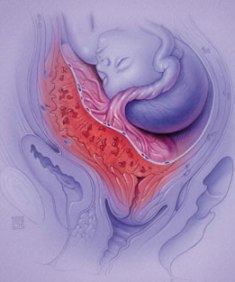Normally placenta attaches to the walls of the uterus. But, during some conditions, placenta attaches itself too deeply to the walls of the uterus.
Usually, this condition is called as placenta accreta or placenta percreta. Generally, this condition is based on the severity and deepness of the placenta attachment.
Normally, one in 2,500 pregnancies has a chance to occur placenta accreta, percreta or increta.
What conditions result in placenta accreta?
Generally, the exact cause behind placenta accreta is still unknown. But, according to some experts, this condition is
 related to placenta previa and the previous cesarean deliveries. Placenta accreta can be observed in 5-10% of pregnant women with placenta previa.
related to placenta previa and the previous cesarean deliveries. Placenta accreta can be observed in 5-10% of pregnant women with placenta previa.
Usually, cesarean delivery raises the chances of placenta accreta in the future. The more the cesarean deliveries, the greater the chances of occurrence of this condition. Multiple cesareans exist in over 60% cases of placenta accreta.
What are the risks associated with placenta accreta to your baby?
The major concerns with placenta accreta to your baby include premature delivery and consequent issues. Bleeding during the third trimester of pregnancy is the common indication that placenta accreta exists and when this condition occurs, it generally results in premature delivery.
The practitioner examines your condition and suggests you to use medications, take plenty of rest and whatever it is necessary to control the condition and continue the pregnancy towards full term.
What are the risks associated with placenta accreta to you?
Usually it will become very difficult to separate the placenta from the walls of the uterus. You will encounter hemorrhage during manual attempts to separate the placenta. Sometimes, severe hemorrhage is a life threatening condition.
Sometimes, there will be great damage to the uterus or other organs of your body during the removal of placenta.
The most common therapeutic intervention is hysterectomy procedure. But, this results in loss of uterus and the ability to conceive.
How to treat the condition of placenta accreta?
Nothing can be done to treat the condition of placenta accreta. But, you can take enough precautions to control the condition once you have diagnosed with placenta accreta. Once this condition is confirmed with your pregnancy, your health care provider schedules the delivery and also uses a surgery that helps to separate the placenta from uterine walls.
Sometimes, hysterectomy is recommended to treat the condition of placenta accreta in most severe cases. But, after this procedure you are not able to conceive. So, it is better to discuss about the possible surgical options with your health care provider.






